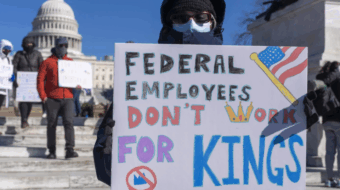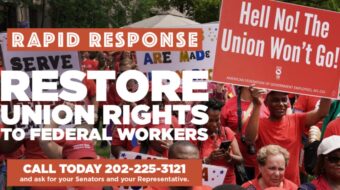
DETROIT—The United Auto Workers set the exact hour last night at which they will expand their historic strike to more than the three plants in three states currently being struck since the walkout began last week.
“I have been crystal clear every step of the way, and I will be crystal clear again,” union President Shawn Fain reported in a September 19 evening Facebook videocast. “If we don’t make serious progress by noon on Friday, September 22nd, more locals will be called upon to stand up and join the strike.”
Fain was not specific about how many locals and workers would be summoned to walk at noon on Friday. Some 12,700 workers combined from locals at the GM plant in the St. Louis suburb of Wentzville, Mo., the Toledo, Ohio, Jeep plant complex, and the Ford paint and final assembly line plant in Wayne County, Mich., have been on the picket lines since midnight September 14-15.
Union locals not called on yet will have their members keep working, though UAW’s contracts with the Big 3 have expired, he said. “That is the only way this works,” Fain declared, pre-empting prior calls from many video respondents for a strike against all the plants of all three car companies.
Under labor law, the status quo stays in place at all the plants. The three car companies combined employ 150,000 UAW members and thousands more in Canada—where their union, Unifor, also is in a struggle with the Detroit 3’s bosses.
Harking back to the sit-down strikes of 1937 in his videocast, Fain characterized the strike as part of a “class struggle” between hard-working Auto Workers in the car company plants and corporate honchos who have collected fat paychecks—along with the Wall Street financiers who back the car companies and who profit from the firms’ stock buybacks.
Buybacks worth billions
Studies show the buybacks alone were worth billions of dollars—money which analysts point out could and should have gone to the workers, who produced the Big 3’s profits.
“Then as now, we face massive inequality. Then as now, our industry is rapidly changing and workers are being left behind,” Fain explained.
Fain reiterated the comparison between the profits of Ford, GM, and Stellantis—what had been Jeep, Chrysler, and other firms—and corporate honchos’ high pay on one hand, and workers’ pay on the other, especially as a component of prices of cars.
Not only did the three firms net $250 billion in profits over the last decade, but the corporate presidents made millions of dollars each. “And over the last four years, new car prices have risen 30%,” he said as a graphic flashed on the screen showing the real hike was 34%.
“Think UAW wages have driven that increase? Think again. Our pay has risen a mere 6% over the last four years. Due to inflation, an auto worker is making less in real wages”—the screen showed 20% less—“than we made 20 years ago.”
The car price comparison was a retort to a particularly slanted NBC News report several days before, where the anchor found one dealer who predicted the strike would drive prices up.
The union’s “Stand Up!” strike campaign is designed to keep the Big 3 off balance by calling union locals to go out at the last minute and without notice to the firms. But it’s also to show the union’s stand “against corporate greed,” to end the two-tier wage system at the Big 3 plants, to restore cost-of-living increases, and to end plant closures which wreck communities.
Indeed one such closure, at the Chrysler/Stellantis plant in Belvidere, Ill., has become a flash point in the back-and-forth between UAW and the firm. That plant was the first, almost 15 years ago, to suffer from the two-tier wage system.
Its imposition at the Belvidere plant ended up pitting worker against worker, devastated the town’s tax base, and hurt not just workers and their families but local businesses—diners, clothing stores, and the like—that depended on its 1,200 workers as customers.
Fain reiterated the UAW presented its comprehensive bargaining proposals to all of the Big 3 approximately eight months ago, but the firms did not take the union seriously until recently.
And the UAW had to file unfair labor practices—labor law-breaking—charges against GM and Stellantis with the Detroit regional office of the National Labor Relations Board to get all three firms to pay attention and provide counteroffers.
Those counters, he said before the strike was called, were totally inadequate. There has been little movement since he said in the video.
“Auto Workers have waited long enough to make things right at the Big 3. So we’re not waiting around and we’re not messing around.”
>>> READ MORE PEOPLE’S WORLD COVERAGE OF THE UAW STRIKE.
We hope you appreciated this article. At People’s World, we believe news and information should be free and accessible to all, but we need your help. Our journalism is free of corporate influence and paywalls because we are totally reader-supported. Only you, our readers and supporters, make this possible. If you enjoy reading People’s World and the stories we bring you, please support our work by donating or becoming a monthly sustainer today. Thank you!










